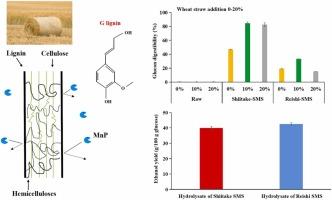当前位置:
X-MOL 学术
›
Ind. Crops Prod.
›
论文详情
Our official English website, www.x-mol.net, welcomes your
feedback! (Note: you will need to create a separate account there.)
Investigation of crop straw for edible and medicinal fungi cultivation: Assessment of lignocellulose preprocessing and spent substrate biofuel properties
Industrial Crops and Products ( IF 5.6 ) Pub Date : 2024-11-09 , DOI: 10.1016/j.indcrop.2024.120004 Yi Yin, Binbin Chen, Shuai Xu, Jinchen Zuo, Yue Xu, Shaojun Xiong, Feng Chen
Industrial Crops and Products ( IF 5.6 ) Pub Date : 2024-11-09 , DOI: 10.1016/j.indcrop.2024.120004 Yi Yin, Binbin Chen, Shuai Xu, Jinchen Zuo, Yue Xu, Shaojun Xiong, Feng Chen

|
Pretreatment with white-rot fungi has advantages of low inputs of energy and chemicals for reducing the recalcitrance of woody biomass for cellulosic ethanol production. This study investigated the effects of substrates ranging from wood to wheat straw on edible and medicinal fungi production, lignocellulose degradation, cellulose saccharification and ethanolic fermentation of the produced hydrolysates. Shiitake cultivation resulted in the most substantial degradation of lignin and xylan. Reishi produced a selective degradation pattern in terms of preferential xylan removal. Oyster had poor performance in lignocellulose degradation. Shiitake and reishi had high reactivity of S-lignin. The strong recalcitrance of >10 % wheat straw addition for mushroom cultivation might be attributed to the low S:G ratio of the substrates. Compared with the substrate comprising a single hardwood, 10 % wheat straw addition optimised the integration process, resulting in a generally comparable fruiting body yield and higher lignocellulose degradation. The shiitake-based and reishi-based spent mushroom substrates (SMSs) contained ∼21 % glucan, which released 84.4 % and 33.5 % of potentially achievable glucose upon enzymatic saccharification, respectively. The SMS hydrolysates ensured ethanol yields corresponding to 78.0 %–83.2 % of the theoretical value in fermentation. The lignocellulose degradation–derived by-products following the fungal pretreatment showed a notable difference compared with thermochemical methods and might cause inhibitory effects on yeast. This study provides valuable insights into the cause of crop straws’s inhibition of white-rot fungi production and reveals the potential of fungal pretreatment as a biorefinery approach producing food and biofuel.
中文翻译:

用于食用和药用真菌培养的作物秸秆研究:木质纤维素预处理和废基质生物燃料特性的评估
用白腐菌预处理的优点是能源和化学品投入少,可以减少木质生物质对纤维素乙醇生产的顽固性。本研究调查了从木材到小麦秸秆的基质对所产生水解物的食用和药用真菌生产、木质纤维素降解、纤维素糖化和乙醇发酵的影响。香菇种植导致木质素和木聚糖的降解最严重。灵芝在优先去除木聚糖方面产生了选择性降解模式。牡蛎在木质纤维素降解方面表现较差。香菇和灵芝对 S-木质素具有高反应性。蘑菇种植中添加 >10 % 小麦秸秆的强烈抵抗可能是由于基质的低 S:G 比。与包含单一硬木的基质相比,添加 10% 的小麦秸秆优化了整合过程,从而产生了大致相当的子实体产量和更高的木质纤维素降解。基于香菇和基于灵芝的废蘑菇底物 (SMS) 含有 ∼21% 的葡聚糖,在酶促糖化后分别释放 84.4% 和 33.5% 的潜在可达到的葡萄糖。SMS 水解物确保乙醇产量相当于发酵理论值的 78.0 %–83.2 %。与热化学方法相比,真菌预处理后木质纤维素降解衍生的副产物显示出显着差异,并可能对酵母产生抑制作用。这项研究为农作物秸秆抑制白腐菌产生的原因提供了有价值的见解,并揭示了真菌预处理作为生产食物和生物燃料的生物精炼方法的潜力。
更新日期:2024-11-09
中文翻译:

用于食用和药用真菌培养的作物秸秆研究:木质纤维素预处理和废基质生物燃料特性的评估
用白腐菌预处理的优点是能源和化学品投入少,可以减少木质生物质对纤维素乙醇生产的顽固性。本研究调查了从木材到小麦秸秆的基质对所产生水解物的食用和药用真菌生产、木质纤维素降解、纤维素糖化和乙醇发酵的影响。香菇种植导致木质素和木聚糖的降解最严重。灵芝在优先去除木聚糖方面产生了选择性降解模式。牡蛎在木质纤维素降解方面表现较差。香菇和灵芝对 S-木质素具有高反应性。蘑菇种植中添加 >10 % 小麦秸秆的强烈抵抗可能是由于基质的低 S:G 比。与包含单一硬木的基质相比,添加 10% 的小麦秸秆优化了整合过程,从而产生了大致相当的子实体产量和更高的木质纤维素降解。基于香菇和基于灵芝的废蘑菇底物 (SMS) 含有 ∼21% 的葡聚糖,在酶促糖化后分别释放 84.4% 和 33.5% 的潜在可达到的葡萄糖。SMS 水解物确保乙醇产量相当于发酵理论值的 78.0 %–83.2 %。与热化学方法相比,真菌预处理后木质纤维素降解衍生的副产物显示出显着差异,并可能对酵母产生抑制作用。这项研究为农作物秸秆抑制白腐菌产生的原因提供了有价值的见解,并揭示了真菌预处理作为生产食物和生物燃料的生物精炼方法的潜力。


















































 京公网安备 11010802027423号
京公网安备 11010802027423号